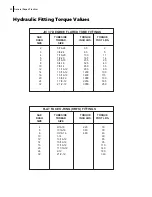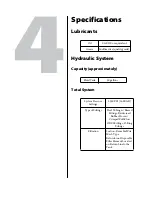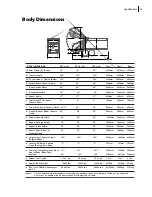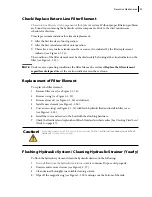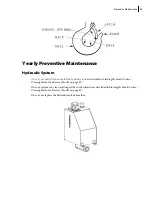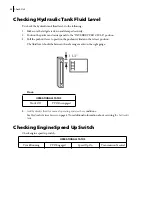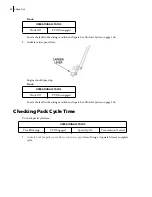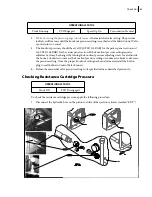
52 Preventive Maintenance
Inspection
In addition to the body mounting hardware
which is checked daily, inspect all other accessible
Check electrical wiring and insulation for frays, breaks and loose connections.
Lubrication
Refer to “Lubrication Chart” on page 46
and service those items which require
weekly lubrication.
Hydraulic System
The return line filter element is vital to the
service life of the hydraulic system. Check the replacement
Also, check the breather cap on the hydraulic tank on a weekly basis. If it is clogged, replace it with a
new one.
Each week perform the check-out procedures listed in Chapter 6 of this manual.
Container Handling System Hardware
Check the container handling system hardware
to make sure that no damage exists and
that all
fasteners are secure.
Pivot Points
Check all pivot points for wear and smooth operation.
Carrier Cylinder Pivot Maintenance
Correct location of the carrier cylinder pivot is critical on the Leach 2R-III to ensure proper carrier
roller positioning and thorough engagement of the carrier cylinder pivot into the carrier hub. The
items locating the carrier cylinder pivot must be inspected during every weekly planned maintenance
cycle.
Ensure that the carrier cylinder pivots are positioned correctly (inserted fully) and the roll pins are
properly inserted through the locating tab, fully into the locating hole in the carrier cylinder pivot.
Check to ensure that the split sleeves are in place and the clamp is tight. The Labrie
Plus
part numbers
for the carrier cylinder pivot locator roll pin, split sleeves and clamp are 102577, 100162, QUC00890,
respectively.
Summary of Contents for 2R-III
Page 1: ...2R III MAINTENANCE MANUAL...
Page 2: ......
Page 3: ...2R III MAINTENANCE MANUAL...
Page 5: ......
Page 6: ......
Page 20: ...10 Introduction...
Page 42: ...32 Safety...
Page 58: ...48 Preventive Maintenance Figure 5 1 Hydraulic tank w return filter 1 2 3 4 5 6 7 8...
Page 66: ...56 Preventive Maintenance...
Page 102: ...92 Troubleshooting...



